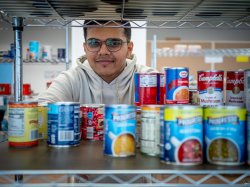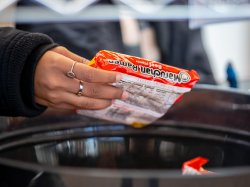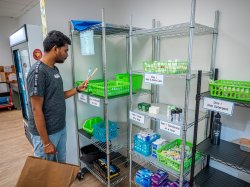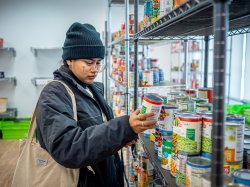Working to Be Hunger Free
Montclair’s efforts to address and destigmatize food insecurity pay off
Posted in: Homepage News, University

With the help of a $100,000 grant in 2021 to fight hunger, Montclair State University continues making strides to address food insecurity. The University participates in the national Swipe Out Hunger program, has added a weekly grocery shuttle service for students needing transportation and the Red Hawk Pantry has moved to a more visible location in Blanton Hall. All are part of the University’s effort to address food insecurity on campus, which has risen to pre-pandemic levels.
In the 2018-2019 academic year, 44% of students surveyed indicated experiencing food insecurity, according to Lauren Dinour, associate professor of Nutrition and Food Studies, who has been surveying students and gathering data on the subject for four years. Those rates dropped considerably both in 2019-2020 (27.9%) and 2020-2021 (24%), most likely due to the pandemic, when the majority of college students returned to their homes. During that time, students reported eating more regular meals, as well as healthier or more culturally acceptable meals, Dinour says.
However, those numbers increased in the 2021-22 academic year, when 44.5% of students surveyed reported experiencing food insecurity. More concerning, she says, is the 26.2% of students who self-reported “very low food security,” the highest level of food insecurity.
“What we’re seeing in very low food security is individuals skipping meals because there’s just not enough resources for food,” says Dinour, who has surveyed 3,884 students to date. “And that’s the one that we’re obviously most concerned with because it means there’s tremendous risk for malnutrition and all of the things that come with that – their ability to concentrate, learn, succeed and be able to graduate.”
There are other concerns, too, she adds: “There’s both the physical and mental-health concerns. There’s a ton of literature on the association between food insecurity and poor mental-health, emotional-health and physical-health outcomes.”
Dinour cautions that because of the survey sample size, the findings do not mean that 26% of Montclair’s enrollment is experiencing very low food security, but she adds, “Even if we looked at the raw number, that’s a pretty high number.”
Dinour and Senior Associate Dean of Students Fatima deCarvalho note that it is not uncommon for college students to experience food insecurity. They say that while many students may have received two meals a day at school through free or reduced lunch programs, there is no such national program to assist college students.
“The number of [college] students that suffer from food insecurity is going to be higher than the national average,” deCarvalho says. “The first time some students are impacted by food insecurity is in college. You can have that stable home life where you have food on the table. There may be some stressors around food but there’s food, and then they come to college, and it’s a different story because all of a sudden, they’re responsible for buying it. They realize, ‘Oh, wow, this costs this much?’ Especially now with the price of groceries going up so high.”
Montclair is committed to normalizing food assistance through various means:
- Through the Swipe Out Hunger program, which the University joined in fall 2021, students can donate meal plan swipes to others to help address their food needs.
- Assisting students who qualify for SNAP benefits enroll. Arian Craig, student support services case manager in the Dean of Students office, says her data, pulled from FAFSA, indicate that 4.2% or 1,988 independent students (those financially responsible for themselves) received SNAP benefits during the 2021-2022 academic year. The grocery shuttle, a service through University Transportation Services, picks up students near Red Hawk Deck every Wednesday between noon and 4 p.m. and takes them to a nearby ShopRite, where some may use their SNAP benefits. The shuttle transports 5 to 10 students for groceries per week.
- Improving the accessibility and offerings at the Red Hawk Pantry, which is open not only to students but faculty and staff who may need food assistance.
Montclair was the first four-year university in New Jersey to open a food pantry on campus in 2016. Today, the Red Hawk Pantry, which is run by the Office for Social Justice and Diversity, has undergone significant changes, moving to a more visible location on campus and increasing the number of hours and days of operation from one day last spring to four days this spring. Moving the Pantry “out of the basement of the Student Center and putting it in a residence hall with windows was a priority for us,” says deCarvalho. “We don’t want food insecurity to be stigmatized. The pantry is like any other service that we offer on this campus. If you’re sick, you go to the Health Center, right? If you need food, you go to the pantry.”
Proof of need is not required to use the Pantry; students, staff or faculty simply have to swipe their University IDs. In addition to offering a variety of foods, the pantry also provides visitors with information on how to apply for SNAP benefits and information on food pantries operated by churches and nonprofit organizations in neighboring counties. Students can also collect recipe cards for simple meals and non-food items, such as laundry soap, toothpaste, toothbrushes and air deodorizer, which are often the first to go. There is also an industrial refrigerator for items such as juices and yogurt, also popular with visitors. The bulk of the Pantry’s inventory, however, is canned foods, such as beans and vegetables, as well as soups and other prepared foods.
According to Meet Bharatbhai Sanariya, pantry coordinator and a graduate assistant in Nutrition and Food Science, the most popular items are laundry detergent and toiletries. The most in-demand foods are peanut butter, pasta and ramen noodles. Canned goods, by comparison, can sit on the shelf for a year, he says.
This was evident among students who were “shopping” the Pantry one December day. Within an hour, toothbrushes, deodorant and air deodorizer disappeared, as did ramen.

“This is my grocery store,” says Ashley Vega, a junior Family Science and Human Development major, who was picking up some Goya Sazón seasoning, shampoo, cleaning supplies and other staples. Although she has a meal plan, she visits the Pantry at least once a week to supplement her food and products, she says.
Ranjeeta Mahraj, a second-year Linguistics major, says she visits the pantry every two to three weeks, mostly for toiletries, cleaning supplies and canned beans. She says the Pantry helps save time and money. “It’s good. I like it a lot,” she says. “For students who struggle, it helps them a lot.”
Sophie Blanc, a senior English major, picked up a brush, deodorant, soaps and canned vegetables. She says before she had her campus job, she visited the Pantry out of necessity more frequently, beginning in her sophomore year. “It’s a good service to have,” she says.

Loads of Goods and Services
Office for Social Justice and Diversity Director Adela Caceres says in the fall semester alone, the Red Hawk Pantry distributed almost 4,400 pounds of food, the majority of the 5,738 pounds distributed during the 2022 calendar year. In addition, 1,541 pounds of personal care and household goods were distributed during that same period, the bulk of the 1,793 pounds distributed all of 2022. During the same period, the Pantry recorded 1,208 visits, more than three-quarters of the 1,526 visits for the entire year. The Pantry currently does not separate unique from repeat visitors.
Caceres notes that the pantry was open on a very limited basis from January through August 2022 because of the pandemic. Last September, thanks to the Governor’s Emergency Education Relief (GEER II) grant, the Pantry opened three times per week, resulting in the larger numbers of food and goods distributed, she says. Operating hours also were expanded to include morning, afternoon and evening openings to better accommodate students. The changes have resulted in “a dramatic increase” of about 100 visits per week, compared to a previous average of about 30, deCarvalho says.

Food Pantry Report
Last fall, Nutrition and Food Science majors Lianna Scherer and Sarah Morella, conducted a survey of Pantry clients and an assessment of the Pantry as part of Dinour’s Applied Community Nutrition class.
Scherer and Morella state in their report that “the role of the Red Hawk Pantry in supporting the Montclair State University community cannot be overstated.” They gave the Pantry high marks in several areas, including the fact that staff and volunteers receive food handler training and certification. However, the report indicated some areas of improvement, including having canned foods with pull tabs because some students did not have can openers.
Other suggestions for the Pantry included:
- Offering recipe cards that call for ingredients found primarily in the pantry.
- Implementing signage on Pantry shelves, identifying key food groups, macro/micronutrients, and beneficial compounds.
- Adding signage about the Pantry around campus.
- Expanding marketing to faculty and staff, in addition to students. “Stigmas surrounding food pantries, especially at one’s place of employment, may keep faculty and staff from visiting the RHFP, even if they may benefit from visiting,” the report states. “Faculty and staff may need a more direct, welcoming, and invitational message to encourage them to visit and use the pantry’s services.”
- A process to differentiate between new and repeat visitors.
- Making more fruits, vegetables, grains and proteins available.
The most surprising finding for Scherer, however, was that students were not eating enough of the variety of foods recommended by the USDA’s Dietary Guidelines for Americans.
“The recommendation for fruits and vegetables, for example, is to have two or three servings per day, but most students were eating them only two or three days per week,” she says. “That was pretty shocking.”
Caceres and deCarvalho are considering the report’s recommendations in order to make improvements.
In addition, case manager Craig is networking with other Montclair staff to establish wraparound services for students with basic needs, from housing, clothing and transportation to tax preparation, family counseling and more. Informally known as the Helping Hands Support Center, she is hoping the center will be a one-stop location in the future. “Most of the services are already provided on campus but students often struggle with connecting to all of the services during a period of crisis,” Craig says. “So instead of the student going to various locations, they can visit one location and be plugged into all of the resources available both on campus and within the community.”
Story by Staff Writer Sylvia A. Martinez. Photos by University Photographer Mike Peters.
To find out more about the Pantry, including hours of operation and how to make donations, visit Red Hawk Pantry.
